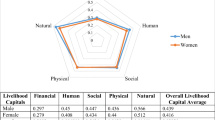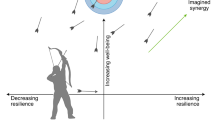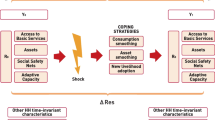Abstract
Poor people are especially vulnerable to shocks and uncertainty driven by climate change, and in particular the increasing frequency and severity of extreme climate events like flooding and droughts. Such shocks exacerbate existing inequalities of power and wealth. This chapter explores whether poor households with greater resilience capacities also enjoy a higher quality of life. Baseline data from two ongoing Oxfam projects with local counterparts provide a rich and novel dataset for exploring these relationships in four distinct geographic and social (socio-spatial) contexts in Bangladesh, Chad, India and Nepal. These different project datasets share a number of common quality of life indicators, as well as proxies for absorptive, adaptive, and transformative resilience capacities. We constructed models with the survey data to explore which factors are associated with better quality of life outcomes and whether resilience capacities are significant explanatory factors. The role of gender is specifically explored in the models. The findings show that even amongst survey respondents who live in communities characterized by high levels of poverty and marginalization, levels of resilience, and most clearly transformative resilience, do have a positive association with quality of life indicators. Older age tends to be associated with lower quality of life indicators. The role of gender is found to be important but the results diverge depending on the project. The chapter concludes with a discussion of the relevance of the findings for development practitioners engaged in resilience work with people living in poverty.
Access this chapter
Tax calculation will be finalised at checkout
Purchases are for personal use only
Similar content being viewed by others
References
Bahadur, A., Lovell, E., Wilkinson, E., & Tanner, T. (2015). Resilience in the SDGs: Developing an indicator for target 1.5 that is fit for purpose. London: Overseas Development Institute.
Béné, C., Newsham, A., & Wood, R. (2014). Resilience, poverty and development. Journal of International Development, 26, 598–623.
De Jonge, T., Veenhoven, R., & Arends, L. (2015). ‘Very happy’ is not always equally happy: On the meaning of verbal response options in survey questions. Journal of Happiness Studies, 16(1), 77–101.
DFID. (2011). Defining disaster resilience: A DFID approach paper. London: DFID.
DFID, Sturgess, P., & Sparrey, R. (2016). Topic guide. Resilience: What is resilience. London: DFID.
Diener, E., & Diener, M. (2009). Cross-cultural correlates of life satisfaction and self-esteem. In Culture and well-being (pp. 71–91). Dordrecht: Springer.
Ellis, F. (1999). Rural livelihood diversity in developing countries: Evidence and policy implications (Vol. 40(1), pp. 1–10). London: Overseas Development Institute.
Felce, D., & Perry, J. (1995). Quality of life: Its definition and measurement. Research in Developmental Disabilities, 16(1), 51–74.
Folke, C. (2006). Resilience: The emergence of a perspective for social-ecological systems analyses. Global Environmental Change, 16(3), 253–267.
Folke, C., Carpenter, S. R., Walker, B., Scheffer, M., Chapin, T., & Rockström, J. (2010). Resilience thinking: Integrating resilience, adaptability and transformability. Ecology & Society, 15(4), 43.
Fuller, R., & Lain, J., (2015). Resilience in impact evaluations: Lessons learned from measuring resilience in Oxfam’s large-N effectiveness reviews. Oxfam Discussion Papers.
Hagerty, M. R., Cummins, R., Ferriss, A. L., Land, K., Michalos, A. C., Peterson, M., & Vogel, J. (2001). Quality of life indexes for national policy: Review and agenda for research. Bulletin of Sociological Methodology/Bulletin de Méthodologie Sociologique, 71(1), 58–78.
Inglehart, R. (2000). Globalization and postmodern values. Washington Quarterly, 23(1), 215–228.
Jeans, H., Thomas, S., & Castillo, G. (2016). The future is a choice: The Oxfam framework and guidance for resilient development. Nairobi: Oxfam International.
Jennings, S., & Manlutac, J. (2016). A companion guide to resilience. Nairobi: Oxfam International.
Long, J. S., & Freese, J. (2006). Regression models for categorical dependent variables using Stata. College Station, TX: Stata Press.
Lyubomirsky, S., Tkach, C., & DiMatteo, M. R. (2006). What are the differences between happiness and self-esteem? Social Indicators Research, 78, 363.
Marmot, M. (2005). Social determinants of health inequalities. The Lancet, 365(9464), 1099–1104.
Martínez, J., Verplanke, J., and Miscione, G. (2017). A geographic and mixed methods approach to capture unequal quality-of-life conditions. In R. Phillips and C. Wong Eds. Handbook of community well-being research (pp. 385-402). Dordrecht: Springer.
McCullagh, P. (1980). Regression models for ordinal data. Journal of the Royal Statistical Society: Series B (Methodological), 42(2), 109–127.
McGee, D. L., Liao, Y., Cao, G., & Cooper, R. S. (1999). Self-reported health status and mortality in a multiethnic US cohort. American Journal of Epidemiology, 149(1), 41–46.
MercyCorps (2013). Exploratory evidence on the determinants of resilience to food security shocks in Southern Somalia. Portland, OR: MercyCorps.
OECD. (2017). How’s life? Measuring well-being. Paris: OECD.
OECD. (2019). The Better Life Initiative. Retrieved from https://www.oecd.org/statistics/better-life-initiative.htm
Oxfam. (2013). The power of people against poverty – Oxfam Strategic Plan 2013-2019. Nairobi: Oxfam International.
Oxfam Novib Impact Measurement and Knowledge. (2018). Résilience et cohésion sociale dans la bande sahélienne et la région du lac Tchad. Oxfam Novib Baseline Report.
Oxfam Novib Impact Measurement and Knowledge. (2019a). Baseline report: Trans-boundary Rivers of South Asia project Bangladesh. Oxfam Novib Baseline Report.
Oxfam Novib Impact Measurement and Knowledge. (2019b). Baseline report: Trans-boundary rivers of South Asia project India. Oxfam Novib Baseline Report.
Oxfam Novib Impact Measurement and Knowledge. (2019c). Baseline report: Trans-boundary Rivers of South Asia project Nepal. Oxfam Novib Baseline Report.
Pasta, D. J. (2009). Learning when to be discrete: Continuous vs. categorical predictors. In SAS Global Forum, Vol. 248.
Ray, I. (2007). Women, water, and development. Annual Review of Environment and Resources, 32, 421–449.
Ross, C. E., & Van Willigen, M. (1997). Education and the subjective quality of life. Journal of Health and Social Behavior, 38(3), 275.
Stiglitz, J. E., Sen, A., & Fitoussi, J. P. (2017). Report by the commission on the measurement of economic performance and social progress. Paris: Commission on the Measurement of Economic Performance and Social Progress.
Tobgay, T., Dophu, U., Torres, C. E., & Na-Bangchang, K. (2011). Health and gross national happiness: Review of current status in Bhutan. Journal of Multidisciplinary Healthcare, 4, 293.
UNDP. (2018). Human development index and its components. Retrieved from http://www.hdr.undp.org/en/composite/HDI
USAID. (2012). Building Resilience to recurrent crisis: USAID policy and program guidance. Washington DC: USAID.
Veenhoven, R. (2001). Quality-of-life and happiness: Not quite the same. Working Paper of the Centro Scientifico Editore Torino, Italia.
Walker, B., Holling, C. S., Carpenter, S. R., & Kinzig, A. (2004). Resilience, adaptability and transformability in social-ecological systems. Ecology and Society, 9(2), 5.
Acknowledgements
Data used in this chapter came from interviews with community members in Bangladesh, Chad, India, and Nepal who kindly took the time to answer our questions. The authors thank all the respondents, as well as those who organized and carried out the data collection. Thanks also to Yahaya Awaiss, Nimul Chun, Elsa Febles, Nynke Kuperus, Valerie Minne, Jyotiraj Patra, Enamul Mazid Khan Siddique, Gerard Steehouwer, Rajan Subedi and Jaynie Vonk.
Author information
Authors and Affiliations
Corresponding author
Editor information
Editors and Affiliations
Rights and permissions
Copyright information
© 2021 Springer Nature Switzerland AG
About this chapter
Cite this chapter
Guyer, P., van Koot – Hodges, C., Weijermars, B. (2021). Are Expanded Resilience Capacities Associated with Better Quality-of-Life Outcomes? Evidence from Poor Households Grappling with Climate Change in Bangladesh, Chad, India and Nepal. In: Martinez, J., Mikkelsen, C.A., Phillips, R. (eds) Handbook of Quality of Life and Sustainability. International Handbooks of Quality-of-Life. Springer, Cham. https://doi.org/10.1007/978-3-030-50540-0_9
Download citation
DOI: https://doi.org/10.1007/978-3-030-50540-0_9
Published:
Publisher Name: Springer, Cham
Print ISBN: 978-3-030-50539-4
Online ISBN: 978-3-030-50540-0
eBook Packages: MedicineMedicine (R0)




